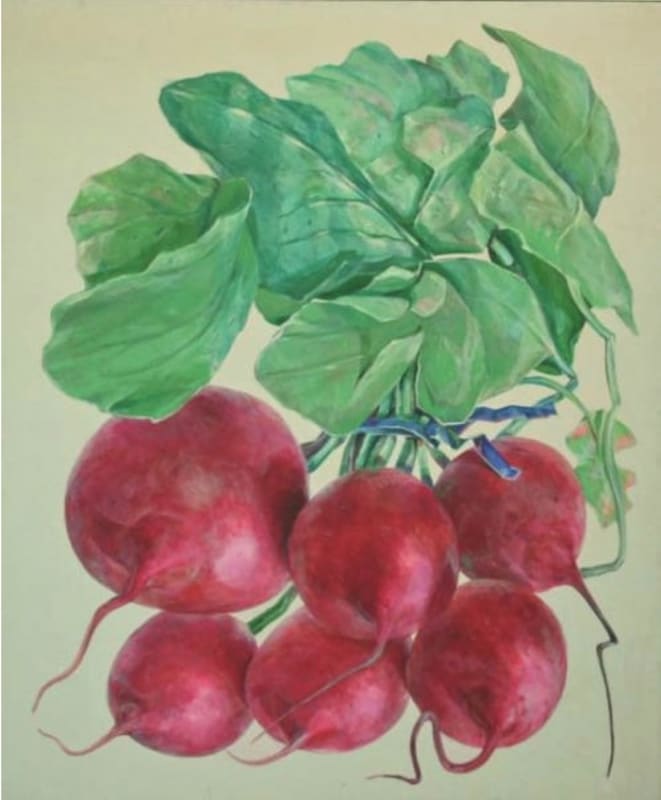Born in 1932 in Visalia, California, outside of Sequoia National Park, Nice spent his childhood surrounded by nature. He grew up herding cattle and listened to his grandfather’s stories of the old American West. His father worked for a fruit company, and his aunt, Madeline Weiman, a talented amateur artist well connected in the California arts community, introduced him to watercolors, found correspondence classes for him, and encouraged him to convert a garden shack on the family property to a studio. Nice was awarded a football scholarship to the University of Southern California, and upon graduating, taught at a local boy’s high school.
After the Korean War, Nice enlisted in the army. He served at Fort Ord and continued to pursue his interest in art, even creating a 24-foot long mural in the dining hall for the soldiers.
After his discharge in 1957, Nice moved to Italy to study painting and eventually traveled to Salzburg, where he took classes taught by Oskar Kokoschka. The rigid classes demanded Nice produce four watercolors an hour, eight hours a day. Kokoschka’s influence is undeniable throughout Nice’s career, including his single-image works and the extensive rivers series that he would later go on to create.
Nice eventually ended up in Paris. The city was not only where he met his American wife, but also where he discovered the groundbreaking exhibition The New American Painting at the Museum of Modern Art. Upon viewing the works of De Kooning and Pollock, Nice knew he wanted to be in the center of the action. With his soon-to-be wife by his side, they packed their bags and moved home to the United States.
Nice taught painting at the Minneapolis School of Art until 1962 when he was accepted into Yale’s Graduate School of Painting. Nice continued to work with abstract forms but was also encouraged to push the boundaries as he studied alongside classmates who included Richard Serra, Nancy Graves, Chuck Close, Robert Mangold, and Brice Marden.
Alex Katz, a visiting critic at the time, played a significant role in helping Nice realize his natural draw of depicting objects around him. Throughout his time at Yale, Nice focused on figurative images and the style of realism. He began to paint motifs heavily influenced by his own childhood when he worked on a ranch and his father’s job on a fruit farm. Some of his most notable works from this time included paintings of advertisements like the Sunkist label. In 1964, Nice graduated from Yale, moved to New York, taking a studio on Broome Street, and focusing on figurative works that felt contemporary and his own.
A pivotal moment came for Nice after he purchased a bunch of grapes from the market. He studied the grapes, painting them over and over, each time larger than the last until he ended up with a canvas over nine feet tall. The massive canvas provided clarity as Nice noticed how these very specific objects were also completely universal. He continued to work on these single images, which included various vegetables, fruits, apple pies, sticks of gum, eagles, and lobsters. These oversized motifs, emblematic of American culture, laid flat against a white canvas and were void of any shadow or perspective.
In 1968, his work was notably included in the group exhibition Realism Now at Vassar College. Within the coming years, Nice was represented by prestigious galleries, and his work was shown consistently in group and solo exhibitions across the US and the globe. In the next decade, Nice also received institutional recognition, and his works were placed in prominent collections and shown in museum exhibitions. His focus on creating single-image pop art works, including processed items like Juicy Fruit gum, Pabst Blue Ribbon beer cans, Converse sneakers, and Coke bottles, put him on the map as a leader in the Pop-Realism movement. He was chosen to paint large murals for the ice arena at the 1980 Lake Placid Olympics, his iconic images representing the essence of American culture at a pivotal moment for a worldwide audience.
In 1969, the California native moved with his family to a home along the Hudson River, and the landscapes and the environmental movement quickly became a primary focus in his work. Images of trees, water, birds, fish, and bears filled the canvas, as he worked to capture the beauty and fragility of the world around him. Nice continued to find inspiration from nature, drawing on Native American totems, American folk art traditions, and the formal conventions of Renaissance altarpieces to contrast single-image and landscapes and create connections between consumer culture and its impact on the environment.
Later in his career, he began to work on fully realized versions of sketches he had made daily since the 1950s, considering alternative ways to depict the environment and his iconic motifs. He experimented with new methods, transforming his paintings by cutting stars and spinners on aluminum. His Earthscapes, Starscapes, and Spinner Scapes are a continuation of his early landscapes, fusing waters, skies, foliage, animals, and man-made objects while teetering on abstraction.
An artist, teacher, environmentalist, and explorer, Nice was known for his pop-realist paintings, watercolor landscapes, and works that broke free from the traditional canvas. He constantly pushed boundaries to depict the 20th-century American landscape, highlight the beauty and fragility in nature, and call attention to the intricate relationship between the environment and American consumerism. He consistently pushed beyond distinguished artistic categories and blended the natural and manmade, abstract and realism, stillness and motion, to create works entirely their own.
